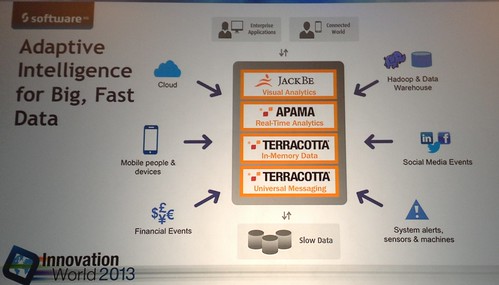John Bates, who I know from his days at Progress Software, actually holds the title SVP of Big Fast Data at Software AG. Love it. He led off the Big Fast Data World sub-conference at Innovation World to talk about real-time decisioning based on events, whether that is financial data such as trades, or device events from an oil rig. This isn’t just simple “if this event occurs, then trigger this action” sort of decisions, but real-time adaptive intelligence that might include social media, internal business systems, market information and more. It’s where events, data, analytics and process all come together.
The goal is to use all of the data and events possible to appear to be reading your customer’s mind and offering them the most likely thing that they want right then (without being too creepy about it), using historical patterns, current context and location information. For example, a customer is in the process of buying something, and their credit card company or retail partner uses that opportunity to upsell them on a related product or a payment plan, directly to their mobile phone and before they have finished making their purchase. Or, a customer is entering a mall, they are subscribed to a sports information service, there are available tables at a sports bar in the mall, so they are pushed a coupon to have lunch at the sports bar right then. Even recommendation engines, such as we see every time that we visit Amazon or Netflix, are examples of this. Completely context sensitive, and completely personalized.
On the flip side, companies have to use continuous monitoring of social media channels for proactive customer care: real-time event and data analysis for responding to unhappy customers before situations blow up on them. People like Dave Carroll and Heather Armstrong (and sometimes even me, on a much smaller scale) can strike fear in the hearts of customer service organizations who are unable to respond appropriately and quickly, but can cause big wins for these companies when they do the right things to fix things in an expedient manner for their customers.
What do you need to do to make this happen? Not much, just low-latency universal messaging, in-memory unstructured data, real-time predictive analytics, intelligent actions via real-time integration to operational systems, and real-time visual analytics. If you’re a Software AG customer, they’re bringing together Terracotta, Apama and JackBe into a unified platform for this sort of adaptive intelligence, producing intelligent actions from big data, in real time, to/from anywhere.
We then got a bit of a lesson on big data from Nathaniel Rowe, a research analyst at Aberdeen Group: how big is big, what’s the nature of that data, and some of the problems with it. The upshot: the fact that there’s a lot of data is important, but it’s the unstructured nature of it that presents many of the difficult analytical problems. It’s about volume, but also variety and velocity: the data could be coming from anywhere, and you don’t have control over a lot of it such as the social media data or that from business partners. You have to have a clear picture of what you want out of big data, such as better customer insights or operational visibility; Rowe had a number of use cases from e-commerce to healthcare to counterterrorism. The ability to effectively use unstructured data is key: those companies that are best in class are doing this better than average, and it translates directly to measures such as sales, customer satisfaction and net promoter score. He finished up with some of the tools required – automatic data capture, data compression, and data cleansing – and how those translate directly to employees’ ability to find data, particularly from multiple sources at once. Real-time analytics and in-memory analytics are the two high-speed technologies that result in the largest measurable benefits when working with big data, making the difference between seconds (or even sub-second) to see a result or take an action, versus minutes or hours. He ended up with the correlation between investing in big data and various customer experience measures (15-18% increases) as well as revenue measures (12-17% increases). Great presentation, although I’m pretty sure that I missed 75% of it since he is a serious speed-talker and zipped through slides at the speed of light.
And we’re done for the day: back tomorrow for another full day of Innovation World. I’m off to the drinks reception then a customer party event; as always, everything is off the record as soon as the bar opens. ![]()

